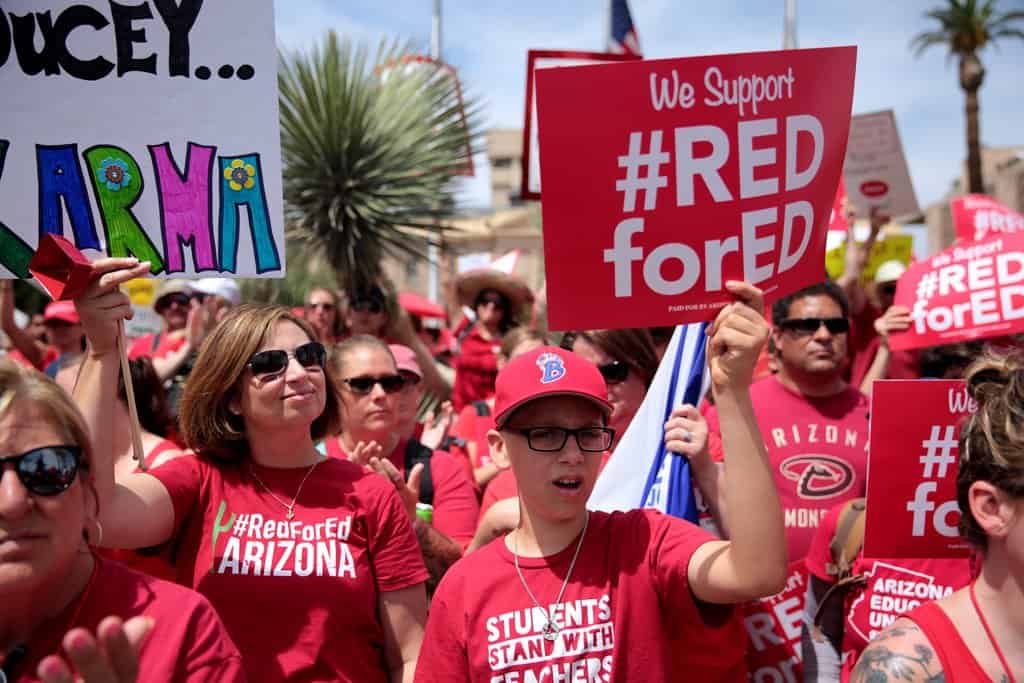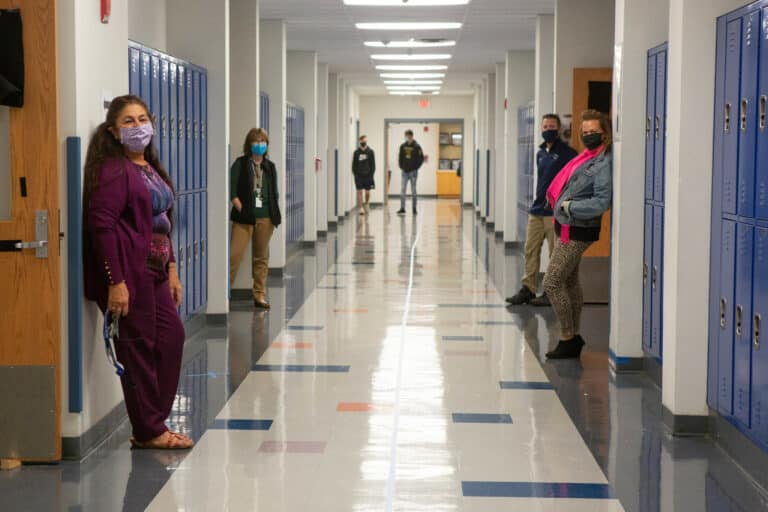For the past couple months, teachers’ strikes have featured prominently in national headlines. The first of these high-profile strikes began on February 22, 2018 when teachers across the state went out on strike. The strike, which protested low pay and high healthcare costs, has since inspired teachers’ strikes across the country, including in Arizona, Kentucky, and Oklahoma. The strikes have primarily concerned low wage rates, including for support staff, pension issues and inadequate funding, produced in part by cuts to education spending in past years.
West Virginia
The first in the wave of teachers’ strikes lasted 9 workdays and was a resounding success for the teachers. The strike began in protest of low teacher salaries—West Virginia teacher salaries ranked 48th in the country in 2016—and increasing health care premiums. Striking teachers also opposed a state plan to boost its contribution to the Public Employees Insurance Agency by using a portion of the annual state surplus. Teachers’ unions criticized the plan as unreliable and emphasized that health care costs had been increasing at a rate unmatched by raises.
Public schools throughout the state were closed for the duration of the strike, heightening the negotiating power of the teachers. Though a deal was announced on February 27, schools called for an additional day of school closure on the 28th because of continuing work stoppages—notwithstanding union leaders’ advice to teachers to return to work after Governor Justice first promised a raise, teachers decided (in in-person meetings and on Facebook groups) not to return to work until the promise was enacted in law. This proved prescient. On March 3, the West Virginia Senate rejected a bill passed in the state House of Delegates approving a 5% raise. This precipitated further striking. A few days later, on March 6, the Republican-controlled legislature passed the promised raise and Governor Justice signed it into law.
Oklahoma
On April 2, 2018, less than one month after teachers’ strikes in West Virginia resulted in a victory for teachers, Oklahoma teachers began walking out of classrooms. By many measures, the state of public education in Oklahoma was even more dire than it is in West Virginia. For example, the average salary of Oklahoma teachers ranked 49th in the country in 2016—behind West Virginia. Largely as a result of low pay and difficult conditions, more than 2,000 Oklahoma public school teaching positions are filled by emergency-certified staff with little training. Since 2008, per-student funding has decreased by 28%. As a result of the drastic budget cuts, almost 20% of Oklahoma public school districts have transitioned to a four-day school week. According to one report, “[t]extbooks are scarce and scandalously out of date; [i]nnumerable arts, languages, and sports courses or programs have been eliminated; [and] class sizes are enormous.”
Oklahoma teachers began to mobilize in March after a bill, dubbed the “Step Up” plan, failed to pass the state legislature. The plan, which comprised various tax and funding reforms, also authorized a $5,000 raise for teachers and certain school staff. The Oklahoma Education Association gave lawmakers until April 1 to implement new funding. April 1 came and went; walkouts began the following day. Teachers, who organized daycare for children with working parents, made several demands. In addition to a salary raise, including raises for support staff, the protesting teachers called for specific legislation to restore classroom funding. The walkout ended after 9 days after reaching an agreement with state lawmakers pursuant to which teachers will receive a $6,000 raise, support staff will receive a $1,250 raise, and new school revenues will be generated by taxes on tobacco, gas, and online sales. Some were unhappy with the funding provision—teachers had pushed for a capital gains tax to support the funding—arguing that the tax is regressive. Nonetheless, the victory is inspiring, and will perhaps inform 2018 midterm elections in the state.
Kentucky
After a pension reform bill was passed on March 29, 2018, many Kentucky teachers called in sick or absent from school the next day in protest. Though Kentucky lawmakers hailed the bill as a compromise, teachers decried various portions of it, including a provision increasing the retirement age to 65, and a phase-out of defined benefit pensions (to be replaced with a “hybrid” retirement plan that teachers view as less stable). In addition to the “sickout,” teachers protested on the Capitol steps. Teachers expressed frustration about not being given a larger opportunity to participate in the negotiation process, and demanded more funding for textbooks and school programming. The situation became especially charged when Governor Matt Bevin said that the teachers’ strike and resulting school closures likely led to child drug use and sexual abuse.
Teachers secured new funding for public education, to be supported largely by an increase in cigarette taxes and some sales tax increases for various home and auto repair services. The legislation passed over Governor Bevin’s veto.
Arizona
The Arizona teachers’ strike was announced on April 20, 2018—teachers voted to walkout beginning April 26, 2018. In so doing, teachers turned down an offered pay raise, insisting on the importance of receiving more school funding. Governor Doug Ducey’s 20 by 2020 plan proposed a 9% raise in teachers’ salaries next year, and 5% in each of the subsequent two years. Teachers were concerned that the plan would simply redirect funding from other education needs. Governor Ducey then announced that there would instead be a 10% raise for teachers in 2019, and another 10% raise in 2020. His announcement was met with skepticism, and did not avert the strike.
Arizona teacher salaries ranked 43rd in the country in 2016. Since the Great Recession, public school funding in Arizona has been cut by 14%. The striking teachers demanded 20% raises for teachers and staff, a return to pre-recession level school funding, and reductions in class size. On May 3, 2018, after just a few days of statewide walkouts, Arizona lawmakers enacted the 20% raise into law. The version of the law that passed is Governor Ducey’s original 20 by 2020 plan. Teachers agreed to end the walkout Thursday notwithstanding their concerns about how the raise might otherwise affect school funding. The Arizona Education Association emphasized that the “fight continues,” and that efforts to reduce class sizes and ensure adequate school funding will persist.
Takeaways
The wave of teachers’ strikes and walkouts is notable because they are happening in red, “right to work,” states. In light of the Supreme Court’s impending decision in Janus (see our coverage, here), which might make every state a right to work state with respect to public employees, this phenomenon of teacher collective action bears special significance. Also notable is the fact that public school teacher strikes are unlawful in these states. For example, in West Virginia, public school teachers have no collective bargaining rights or a right to strike. But because the teachers had the support of their schools, and the superintendents closed the schools while teachers walked out, they managed, technically, not to run afoul of the law. The nationwide teachers’ movement also stands out for the role social media has played in organizing and mobilizing protests. Facebook groups have facilitated collaboration between teachers across the state, and permitted protesting teachers to combat pernicious narratives spouted by politicians. Finally, local support for the teacher protests, including support from parents, has played a key role in the “Red State Revolt.” Parents and students have walked alongside teachers in marches across the country. Some parents have even opened up their homes to offer free childcare to working parents during the school closures.








Daily News & Commentary
Start your day with our roundup of the latest labor developments. See all
July 11
Regional director orders election without Board quorum; 9th Circuit pauses injunction on Executive Order; Driverless car legislation in Massachusetts
July 10
Wisconsin Supreme Court holds UW Health nurses are not covered by Wisconsin’s Labor Peace Act; a district judge denies the request to stay an injunction pending appeal; the NFLPA appeals an arbitration decision.
July 9
the Supreme Court allows Trump to proceed with mass firings; Secretary of Agriculture suggests Medicaid recipients replace deported migrant farmworkers; DHS ends TPS for Nicaragua and Honduras
July 8
In today’s news and commentary, Apple wins at the Fifth Circuit against the NLRB, Florida enacts a noncompete-friendly law, and complications with the No Tax on Tips in the Big Beautiful Bill. Apple won an appeal overturning a National Labor Relations Board (NLRB) decision that the company violated labor law by coercively questioning an employee […]
July 7
LA economy deals with fallout from ICE raids; a new appeal challenges the NCAA antitrust settlement; and the EPA places dissenting employees on leave.
July 6
Municipal workers in Philadelphia continue to strike; Zohran Mamdani collects union endorsements; UFCW grocery workers in California and Colorado reach tentative agreements.